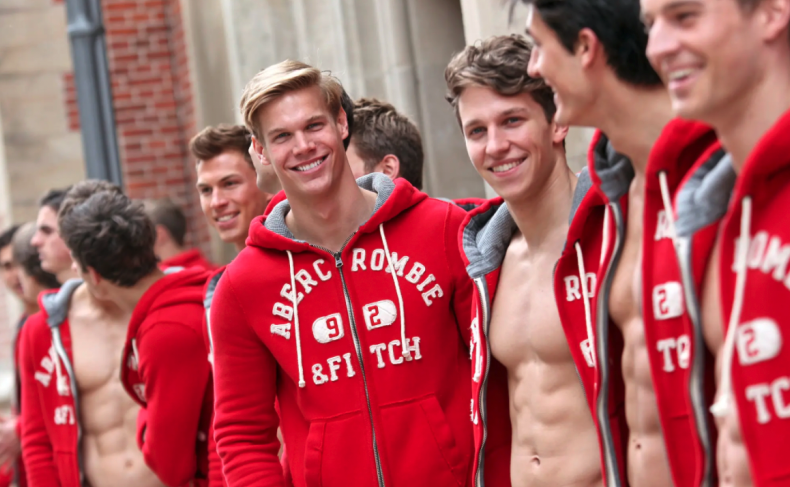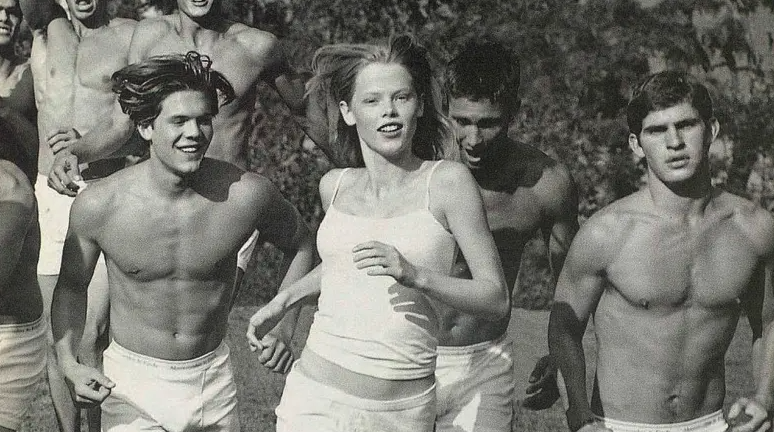White Hot: The Rise and Fall of Abercrombie & Fitch is a new documentary on Netflix that’s sparking conversation online – mainly because we all lived through the American label’s rise to the height of mass fashion, and never questioned the truly toxic culture it both fostered and promoted.
We did not have Abercrombie & Fitch in Australia, but if you made a trip to the States at some point, you definitely visited one of the huge stores the brand had dotted across the country. Along with Sephora, H&M and Abercrombie’s sister label, Hollister, it was a must-shop destination for us in our teens and twenties.
In America, the label was truly the one to be seen wearing in high school and college. As the documentary shows, this was the target market for Abercrombie & Fitch, which makes its messaging and culture all the more horrific. This was a label that was focused on young people, but presented a predominantly white fantasy via its advertising and storefronts, which featured shirtless men on the doors, and hired based on appearances.

During the documentary we hear from ex staff, who describe deeply racist store handbooks that meticulously outlined what staff could or couldn’t wear – right down to their hair, where “dreadlocks are unacceptable for men and women”, and hairstyles could only be “neatly combed, attractive, classic” – in 2015, the Supreme Court ruled against A&F after Samantha Elauf, a sales associate, was told in 2008 her hijab was against the company’s “look policy”.
Watching the documentary brings a wave of nostalgia as a Millennial who grew up coveting the label, mixed with the horror of realising that, once again, what we adored and perceived as acceptable in the 2000s was actually deeply problematic. For example, another moment the documentary touches on is the rise of slogan tees, which Abercrombie & Fitch became famous for. One infamous slogan tee from the label featured a fake laundry service brand called ‘Wong Brothers’ with the racist sell “two Wongs can make it white”. This shirt, along with others promoting Asian stereotypes, led to college protests in 2002.
Shirts like these, however, were ubiquitous in the 2000s, as was whitewashed advertising. What is most shocking about the Abercrombie & Fitch story is that it wasn’t just a part of the existing culture with its racism and exclusion, it was working hard – arguably harder than any other brand at the time – to market itself as exclusionary.

Under the eye of now-controversial photographer Bruce Weber (fifteen male models spoke to the New York Times in 2018 about his “coercive sexual behaviour” and unnecessary nudity), Abercrombie’s ads featured predominantly white men and women, and embodied the ‘00s frat culture popular at the time. Former CEO Mike Jeffries, the man responsible for Abercrombie’s rise in the American zeitgeist, even said in a Salon interview in 2006 “We go after the cool kids. We go after the attractive all-American kid with a great attitude and a lot of friends. A lot of people don’t belong [in our clothes], and they can’t belong. Are we exclusionary? Absolutely.”

Thinking back to the Abercrombie & Fitch stores after watching the documentary, it’s clear that the marketing strategy was one of intimidation. Sizes famously only ran to a Large in the 2000s, and the presence of shirtless men at the door, plus a floor staff of slim, attractive, predominantly white men and women meant shopping at an Abercrombie & Fitch store made me feel this mixture of “wait, am I allowed to shop here” and “if I buy these items, maybe I will look like these people”. You felt bad about yourself and by extension, a desperate need to fit in.
By 2017, Abercrombie & Fitch was completely overhauling its image. Jeffries left the business in 2014, and current CEO Fran Horowitz turned that exclusivity into inclusivity – the Abercrombie site today shares a vastly different message to the stores back in the 00s – at the time of writing, the site was promoting an activewear line that featured a truly diverse range of models, a far cry from the rock-hard ab shots favoured by the brand in the past.
Maybe the surge in interest around the label after White Hot: The Rise & Fall Of Abercrombie & Fitch will see a renaissance for the label. If there’s one thing the documentary proves, it’s that change is possible – when the label wants it.


